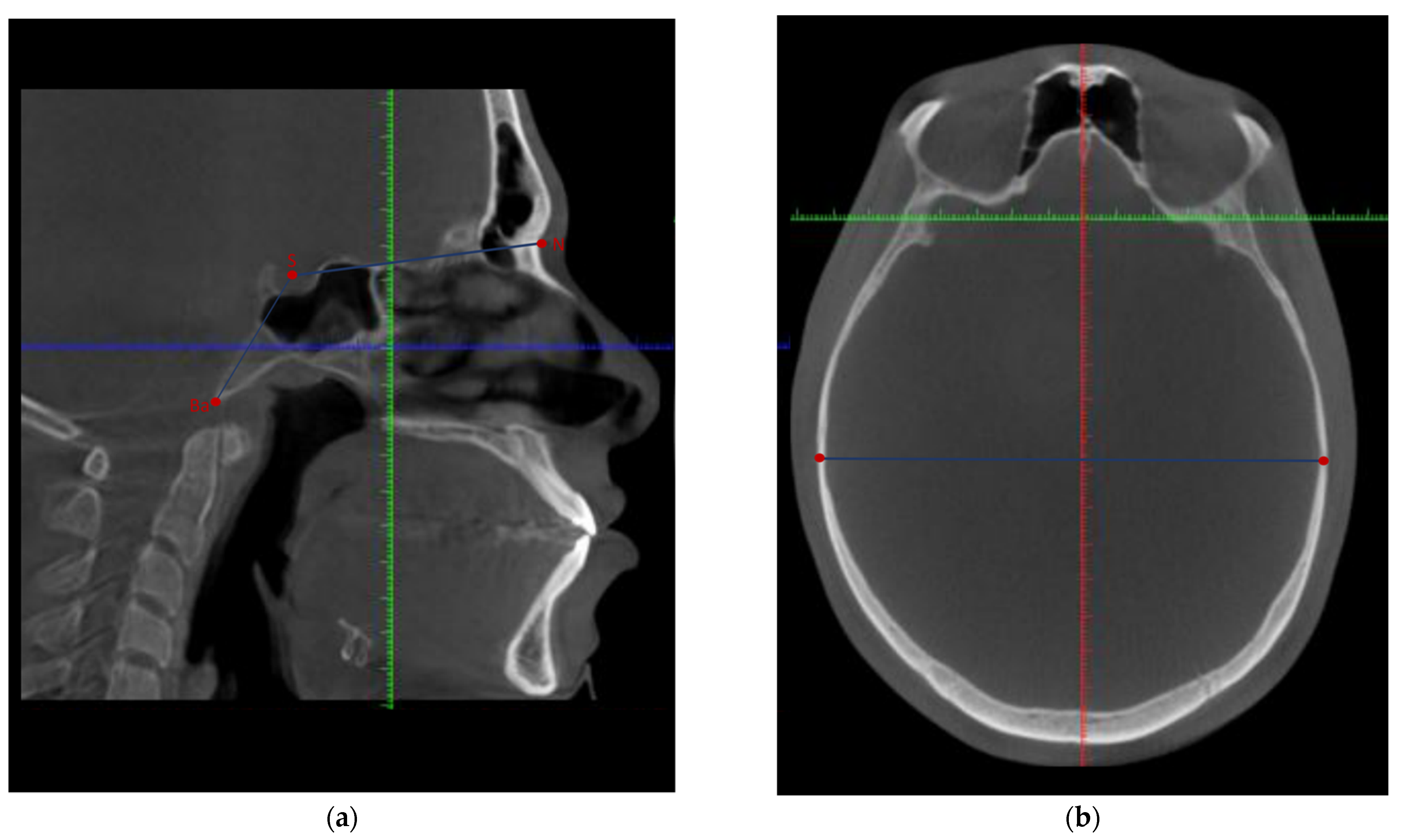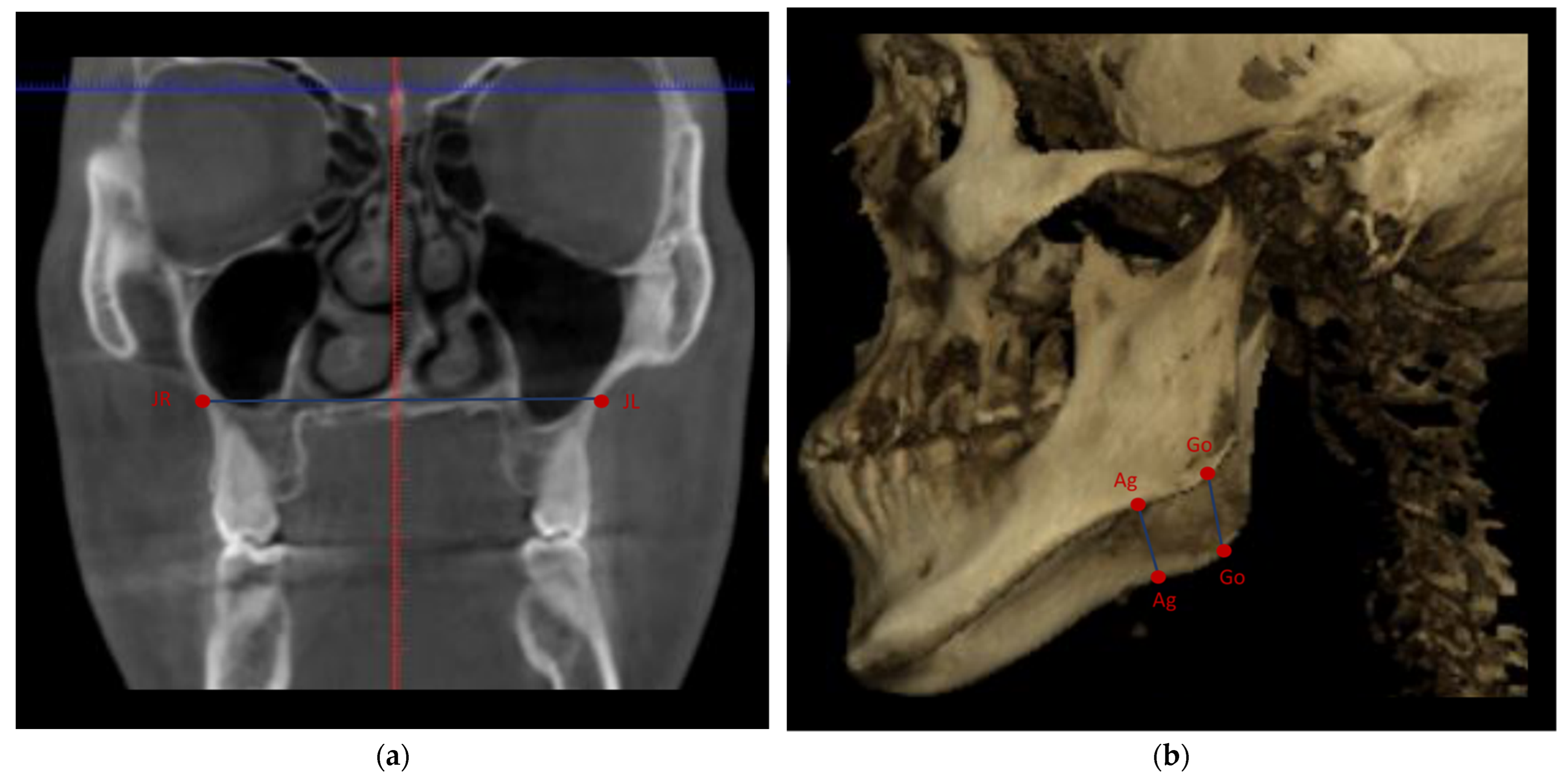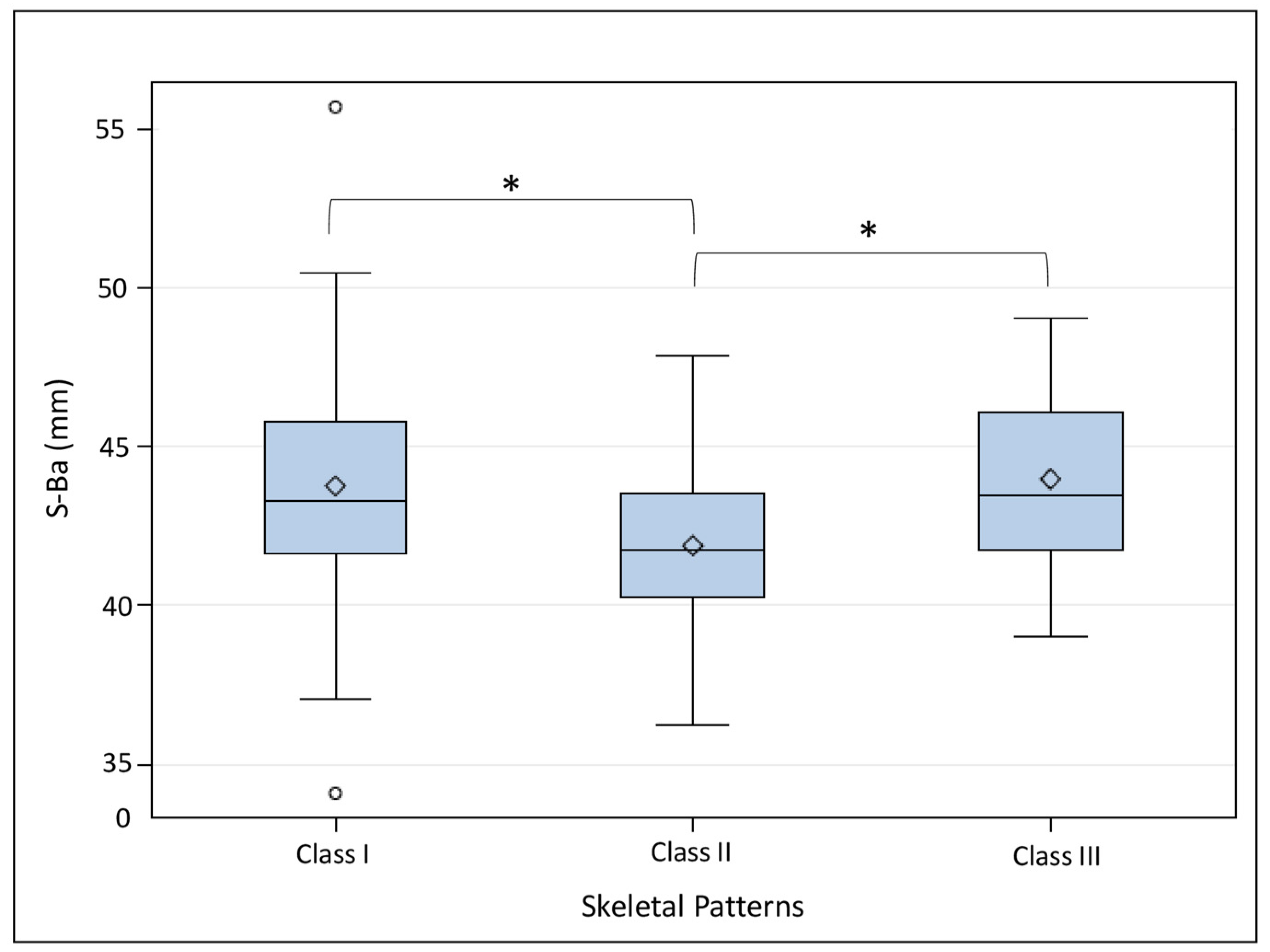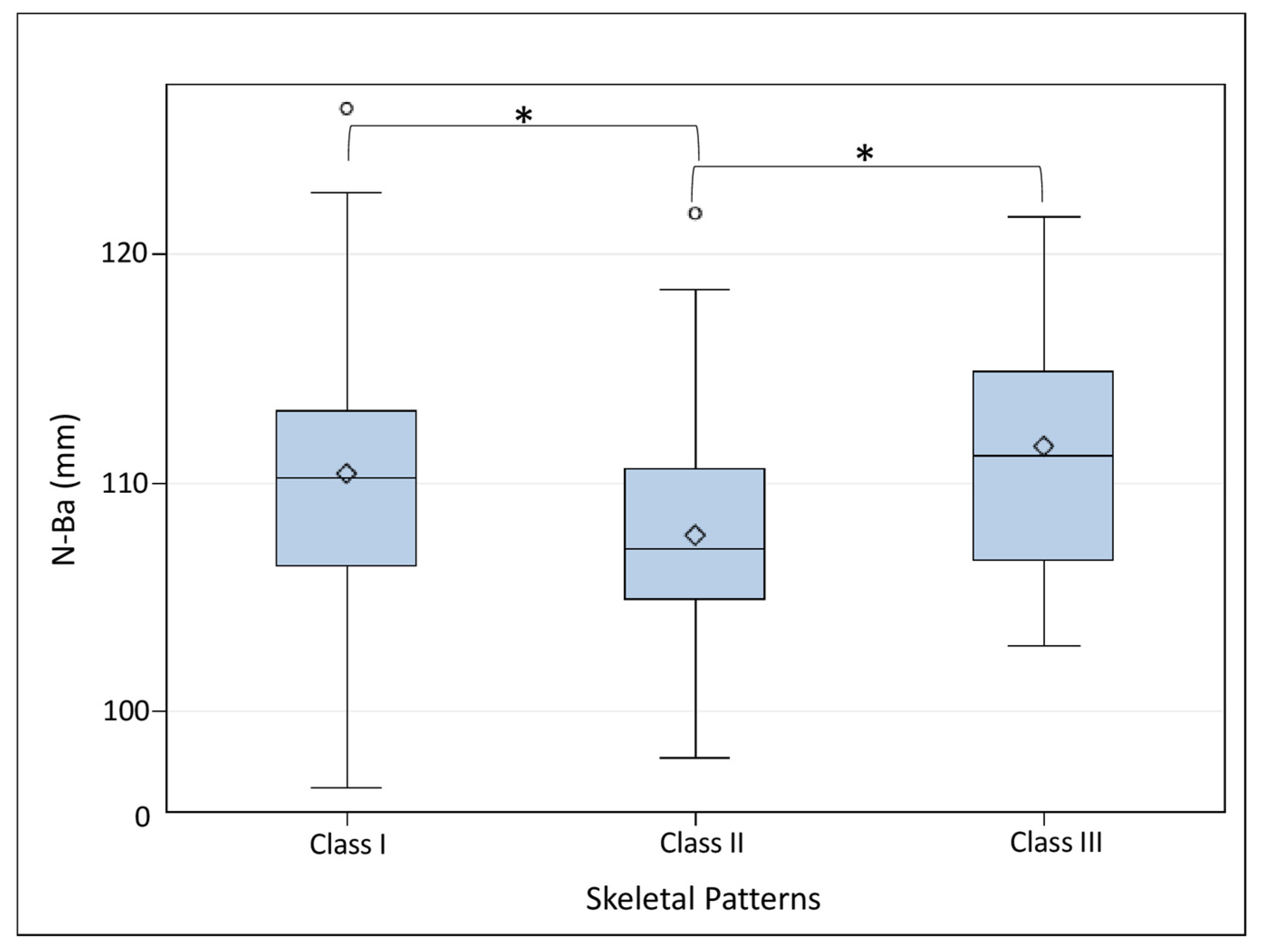The Association between Cranial Base and Maxillomandibular Sagittal and Transverse Relationship: A CBCT Study
Abstract
1. Introduction
2. Materials and Methods
3. Results
4. Discussion
5. Conclusions
- Skeletal class II subjects have smaller posterior and total cranial base lengths.
- There are no significant differences between cranial width and transverse jaw dimensions among the skeletal groups.
- Females were more likely to have reduced linear cranial base measurements compared to males.
Author Contributions
Funding
Institutional Review Board Statement
Informed Consent Statement
Data Availability Statement
Conflicts of Interest
References
- Polat, Ö.; Kaya, B. Changes in cranial base morphology in different malocclusions. Orthod. Craniofacial Res. 2007, 10, 216–221. [Google Scholar] [CrossRef] [PubMed]
- Dhopatkar, A.; Bhatia, S.; Rock, P. An Investigation Into the Relationship Between theCranial Base Angle and Malocclusion. Angle Orthod. 2002, 72, 456–463. [Google Scholar]
- Chin, A.; Perry, S.; Liao, C.; Yang, Y. The relationship between the cranial base and jaw base in a Chinese population. Head Face Med. 2014, 10, 31. [Google Scholar] [CrossRef] [PubMed]
- Scott, J. The cranial base. Am. J. Phys. Anthropol. 1958, 16, 319–348. [Google Scholar] [CrossRef] [PubMed]
- Kerr, W.J.S.; Philip Adams, C. Cranial base and jaw relationship. Am. J. Phys. Anthropol. 1988, 77, 213–220. [Google Scholar] [CrossRef]
- Monirifard, M.; Sadeghian, S.; Afshari, Z.; Rafiei, E.; Sichani, A.V. Relationship between cephalometric cranial base and anterior-posterior features in an Iranian population. Dent. Res. J. 2020, 17, 60. [Google Scholar]
- Gong, A.; Li, J.; Wang, Z.; Li, Y.; Hu, F.; Li, Q.; Miao, D.; Wang, L. Cranial base characteristics in anteroposterior malocclusions: A meta-analysis. Angle Orthod. 2016, 86, 668–680. [Google Scholar] [CrossRef]
- Kerr, W.J.S.; Ford, I. The variability of some craniofacial dimensions. Angle Orthod. 1991, 61, 205–210. [Google Scholar]
- Proff, P.; Will, F.; Bokan, I.; Fanghänel, J.; Gedrange, T. Cranial base features in skeletal Class III patients. Angle Orthod. 2008, 78, 433–439. [Google Scholar] [CrossRef]
- Kuroe, K.; Rosas, A.; Molleson, T. Variation in the cranial base orientation and facial skeleton in dry skulls sampled from three major populations. Eur. J. Orthod. 2004, 26, 201–207. [Google Scholar] [CrossRef]
- Chien, P.; Parks, E.; Eraso, F.; Hartsfield, J.; Roberts, W.; Ofner, S. Comparison of reliability in anatomical landmark identification using two-dimensional digital cephalometrics and three-dimensional cone beam computed tomography in Vivo. Dentomaxillofac. Radiol. 2009, 38, 262–273. [Google Scholar] [CrossRef] [PubMed]
- Baccetti, T.; Antonini, A.; Franchi, L.; Tonti, M.; Tollaro, I. Glenoid fossa position in different facial types: A cephalometric study. Br. J. Orthod. 1997, 24, 55–59. [Google Scholar] [CrossRef] [PubMed]
- Ishii, N.; Deguchi, T.; Hunt, N.P. Morphological differences in the craniofacial structure between Japanese and Caucasian girls with Class II Division 1 malocclusions. Eur. J. Orthod. 2002, 24, 61–67. [Google Scholar] [CrossRef] [PubMed]
- Hayashi, I. Morphological relationship between the cranial base and dentofacial complex obtained by reconstructive computer tomographic images. Eur. J. Orthod. 2003, 25, 385–391. [Google Scholar] [CrossRef][Green Version]
- Mouakeh, M. Cephalometric evaluation of craniofacial pattern of Syrian children with Class III malocclusion. Am. J. Orthod. Dentofac. Orthop. 2001, 119, 640–649. [Google Scholar] [CrossRef]
- Steiner, C.C. The use of cephalometrics as an aid to planning and assessing orthodontic treatment: Report of a case. Am. J. Orthod. 1960, 46, 721–735. [Google Scholar] [CrossRef]
- Ishikawa, H.; Nakamura, S.; Iwasaki, H.; Kitazawa, S. Seven parameters describing anteroposterior jaw relationships: Postpubertal prediction accuracy and interchangeability. Am. J. Orthod. Dentofac. Orthop. 2000, 117, 714–720. [Google Scholar] [CrossRef]
- Koo, T.K.; Li, M.Y. A guideline of selecting and reporting intraclass correlation coefficients for reliability research. J. Chiropr. Med. 2016, 15, 155–163. [Google Scholar] [CrossRef]
- Arnett, G.W.; Bergman, R.T. Facial keys to orthodontic diagnosis and treatment planning. Part I. Am. J. Orthod. Dentofac. Orthop. 1993, 103, 299–312. [Google Scholar] [CrossRef]
- Sassouni, V. Diagnosis and treatment planning via roentgenographic cephalometry. Am. J. Orthod. 1958, 44, 433–463. [Google Scholar] [CrossRef]
- Li, C.; Teixeira, H.; Tanna, N.; Zheng, Z.; Chen, S.H.Y.; Zou, M.; Chung, C.-H. The reliability of two-and three-dimensional cephalometric measurements: A CBCT study. Diagnostics 2021, 11, 2292. [Google Scholar] [CrossRef] [PubMed]
- Wilhelm, B.M.; Beck, F.M.; Lidral, A.C.; Vig, K.W. A comparison of cranial base growth in Class I and Class II skeletal patterns. Am. J. Orthod. Dentofac. Orthop. 2001, 119, 401–405. [Google Scholar] [CrossRef] [PubMed]
- Powell, T.V.; Brodie, A.G. Closure of the spheno-occipital synchondrosis. Anat. Rec. 1963, 147, 15–23. [Google Scholar] [CrossRef] [PubMed]
- Ford, E. Growth of the human cranial base. Am. J. Orthod. 1958, 44, 498–506. [Google Scholar] [CrossRef]
- Dixon, A.D.; Hoyte, D.A.; Ronning, O. Fundamentals of Craniofacial Growth; Crc Press: Boca Raton, FL, USA, 2017. [Google Scholar]
- Bastir, M.; Rosas, A.; O’Higgins, P. Craniofacial levels and the morphological maturation of the human skull. J. Anat. 2006, 209, 637–654. [Google Scholar] [CrossRef]
- Nanda, S.K. Growth patterns in subjects with long and short faces. Am. J. Orthod. Dentofac. Orthop. 1990, 98, 247–258. [Google Scholar] [CrossRef]
- Aldrees, A.M. Pattern of skeletal and dental malocclusions in Saudi orthodontic patients. Saudi Med. J. 2012, 33, 315–320. [Google Scholar]
- Trottman, A.; Elsbach, H.G. Comparison of malocclusion in preschool black and white children. Am. J. Orthod. Dentofac. Orthop. 1996, 110, 69–72. [Google Scholar] [CrossRef]
- Bugaighis, I.; Karanth, D. The prevalence of malocclusion in urban Libyan schoolchildren. J. Orthod. Sci. 2013, 2, 1–6. [Google Scholar] [CrossRef]
- Sanggarnjanavanich, S.; Sekiya, T.; Nomura, Y.; Nakayama, T.; Hanada, N.; Nakamura, Y. Cranial-base morphology in adults with skeletal Class III malocclusion. Am. J. Orthod. Dentofac. Orthop. 2014, 146, 82–91. [Google Scholar] [CrossRef]
- Al Maaitah, E.F.; Alomari, S.; Al-Khateeb, S.N.; Abu Alhaija, E.S. Cranial base measurements in different anteroposterior skeletal relationships using Bjork-Jarabak analysis. Angle Orthod. 2022, 92, 613–618. [Google Scholar] [CrossRef] [PubMed]
- Rothstein, T.; Yoon-Tarlie, C. Dental and facial skeletal characteristics and growth of males and females with Class II, Division 1 malocclusion between the ages of 10 and 14 (revisited)—Part I: Characteristics of size, form, and position. Am. J. Orthod. Dentofac. Orthop. 2000, 117, 320–332. [Google Scholar] [CrossRef]
- Sundareswaran, S.; Thirumoorty, S.N. Anterior cranial base features in skeletal Class III patients with maxillary recession: A cephalometric study. ORTHODONTICS Art Pract. Dentofac. Enhanc. 2012, 13, e105–e115. [Google Scholar]
- Björk, A. Cranial base development: A follow-up x-ray study of the individual variation in growth occurring between the ages of 12 and 20 years and its relation to brain case and face development. Am. J. Orthod. 1955, 41, 198–225. [Google Scholar] [CrossRef]
- Bhatia, S.; Leighton, B. Manual of Facial Growth: A Computer Analysis of Longitudinal Cephalometric Growth Data; Oxford University Press, Inc.: New York, NY, USA, 1993. [Google Scholar]
- Sayın, M.; Türkkahraman, H. Cephalometric evaluation of nongrowing females with skeletal and dental Class II, division 1 malocclusion. Angle Orthod. 2005, 75, 656–660. [Google Scholar] [PubMed]
- Gershater, E.; Li, C.; Ha, P.; Chung, C.-H.; Tanna, N.; Zou, M.; Zheng, Z. Genes and Pathways Associated with Skeletal Sagittal Malocclusions: A Systematic Review. Int. J. Mol. Sci. 2021, 22, 13037. [Google Scholar] [CrossRef]
- Shibata, S.; Suda, N.; Yoda, S.; Fukuoka, H.; Ohyama, K.; Yamashita, Y.; Komori, T. Runx2-deficient mice lack mandibular condylar cartilage and have deformed Meckel’s cartilage. Anat. Embryol. 2004, 208, 273–280. [Google Scholar] [CrossRef]
- Lei, W.Y.; Wong, R.W.; Rabie, A. Factors regulating endochondral ossification in the spheno-occipital synchondrosis. Angle Orthod. 2008, 78, 215–220. [Google Scholar] [CrossRef]
- Thiesen, G.; Pletsch, G.; Zastrow, M.D.; Valle, C.V.M.d.; Valle-Corotti, K.M.d.; Patel, M.P.; Conti, P.C.R. Comparative analysis of the anterior and posterior length and deflection angle of the cranial base, in individuals with facial Pattern I, II and III. Dent. Press J. Orthod. 2013, 18, 69–75. [Google Scholar] [CrossRef]
- Awad, A.M.; Gaballah, S.M.; Gomaa, N.E. Relationship between cranial base and jaw base in different skeletal patterns. Orthod. Waves 2018, 77, 125–133. [Google Scholar] [CrossRef]
- Flores-Ysla, A.; Arriola-Guillén, L.E.; Rodríguez-Càrdenas, Y.A.; Ruíz-Mora, G.A.; Aliaga-Del Castillo, A.; Janson, G. Skeletal open bite cranial base characteristics in young Latin-American individuals with class I, II and III malocclusions: An observational study. Int. Orthod. 2020, 18, 237–245. [Google Scholar] [CrossRef] [PubMed]
- Lewis, A.B.; Roche, A.F.; Wagner, B. Pubertal spurts in cranial base and mandible. Comparisons within individuals. Angle Orthod. 1985, 55, 17–30. [Google Scholar] [PubMed]
- Wu, X.-P.; Xuan, J.; Liu, H.-Y.; Xue, M.-R.; Bing, L. Morphological Characteristics of the Cranial Base of Early Angle’s Class II Division 1 Malocclusion in Permanent Teeth. Int. J. Morphol. 2017, 35, 589–595. [Google Scholar] [CrossRef]
- Andria, L.M.; Leite, L.P.; Prevatte, T.M.; King, L.B. Correlation of the cranial base angle and its components with other dental/skeletal variables and treatment time. Angle Orthod. 2004, 74, 361–366. [Google Scholar]
- Bishara, S.E.; Fahl, J.A.; Peterson, L.C. Longitudinal changes in the ANB angle and Wits appraisal: Clinical implications. Am. J. Orthod. 1983, 84, 133–139. [Google Scholar] [CrossRef]




| Landmark | Abbreviation (Unit) | Definition | Sagittal View | Axial View | Coronal View |
|---|---|---|---|---|---|
| Sella-Nasion | S-N (mm) | Anterior cranial base length in millimeters | Distance between the middle point of the pituitary fossa and the anterior-most point of the frontonasal suture | Distance between the middle point of the anteroposterior and lateral width of the pituitary fossa and the middle–anterior-most point of the frontonasal suture | Distance between the middle point of the lateral width of the pituitary fossa is determined by the sagittal and axial views and the anterior–middle point of the frontonasal suture |
| Sella-Basion | S-Ba (mm) | Posterior cranial base length in millimeters | Distance between the middle point of the pituitary fossa and the inferior–posterior-most part on the anterior margin of the foramen magnum | Distance between the middle point of the anteroposterior and lateral width of the pituitary fossa and the anterior-most point of the anterior margin of the foramen magnum | Distance between the middle point of the lateral width of the pituitary fossa determined by the sagittal and axial views and the middle point on the anterior margin of the foramen magnum |
| Nasion-Basion | N-Ba (mm) | Total cranial base length in millimeters | The total linear distance between the anterior-most point of the frontonasal suture, the middle point of the pituitary fossa, and the inferior–posterior-most part on the anterior margin of the foramen magnum | The total linear distance between the middle–anterior-most point of the frontonasal suture, the middle point of the anteroposterior and lateral width of the pituitary fossa, and the anterior-most point of the anterior margin of the foramen magnum | The total linear distance between the anterior–middle point of the frontonasal suture, between the middle point of the lateral width of the pituitary fossa, and the middle point on the anterior margin of the foramen magnum |
| Nasion-Sella-Basion | N-S-Ba (°) | Cranial base angle in degrees | The angle between the anterior-most point of the frontonasal suture, the middle point of the pituitary fossa, and the inferior–posterior-most part on the anterior margin of the foramen magnum | The angle between the middle–anterior-most point of the frontonasal suture, the middle point of the anteroposterior and lateral width of the pituitary fossa, and the anterior-most point of the anterior margin of the foramen magnum | The angle between the anterior–middle point of the frontonasal suture, between the middle point of the lateral width of the pituitary fossa, and the middle point on the anterior margin of the foramen magnum |
| A point-Nasion-B point | ANB (°) | The relative position of the maxilla to mandible in degrees | The angle between the most posterior point of the maxillary alveolus concavity, the anterior-most point of the frontonasal suture, and the deepest concavity anteriorly on the mandibular symphysis | The angle between the middle–anterior-most point on the maxillary alveolus contour, the middle–anterior-most point of the frontonasal suture, and the middle–anterior-most point on the mandibular symphysis | The angle between the middle point on the maxillary alveolus as determined by the sagittal and axial views, the anterior–middle point of the frontonasal suture, and the middle point on the mandibular symphysis as determined by the sagittal and axial views |
| Cranial width | Bieuryon width (mm) | Distance between the most lateral points on the cranium in millimeters | Distance between the right inferior-most lateral point of the cranium to the contralateral side | Distance between the right posterior-most lateral point of the cranium to the contralateral side | Distance between the right inferior-most lateral point of the cranium to the contralateral side |
| Maxillary width | JR-JL (mm) | The jugal process is the intersection of maxillary tuberosity outline and zygomatic buttress. Distance between the right jugal process and left jugal process in millimeters | Distance between the inferior-most point of the right jugal process and the inferior-most point of the left jugal process | The point determined on the sagittal and coronal views | Distance between the deepest midpoint of the right jugal process and the deepest midpoint of the left jugal process |
| Gonion right-Gonion left | Go (r)-Go (l) (mm) | Mandibular width in millimeters | Distance between the right inferior- and posterior-most point of the mandibular corpus to the contralateral side | Distance between the right posterior-most point of the mandibular corpus to the contralateral side | Distance between the right inferior-most point of mandibular corpus to the contralateral side |
| Antigonion right-Antigonion left | Ag (r)-Ag (l) (mm) | Mandibular width in millimeters | Distance between the right inferior and posterior of the notch of the lower border of the body of the mandible to the contralateral side | Distance between the right posterior of the notch of the lower border of the body of the mandible to the contralateral side | Distance between the right deepest midpoint of the lower border of the body of the mandible to the contralateral side |
| Skeletal Pattern | N | Percentage (%) | Female | Male |
|---|---|---|---|---|
| Class I | 53.00 | 40.15 | 22.00 | 31.00 |
| Class II | 58.00 | 43.93 | 44.00 | 14.00 |
| Class III | 21.00 | 15.90 | 6.00 | 15.00 |
| Total/Percentage | 132.00 | 100.00 | 72.00 (54.54%) | 60.00 (45.45%) |
| Skeletal Pattern | Mean | Standard Deviation | Median | IQR | Minimum | Maximum |
|---|---|---|---|---|---|---|
| Class I | 37.06 | 13.72 | 35.00 | 25.00 | 18.00 | 68.00 |
| Class II | 34.45 | 12.76 | 30.50 | 16.00 | 18.00 | 67.00 |
| Class III | 31.76 | 9.84 | 30.00 | 11.00 | 18.00 | 57.00 |
| Skeletal Pattern | N | Cephalometric Landmarks | Mean | Standard Deviation |
|---|---|---|---|---|
| Class I | 53.00 | S-N (mm) | 66.64 | 3.46 |
| S-Ba (mm) | 43.76 | 3.67 | ||
| N-Ba (mm) | 110.40 | 5.65 | ||
| N-S-Ba (°) | 129.46 | 5.52 | ||
| Bieuryon width (mm) | 138.75 | 7.43 | ||
| JR-JL (mm) | 58.86 | 5.27 | ||
| Go (r)-Go (l) (mm) | 92.52 | 7.70 | ||
| Ag (r)-Ag (l) (mm) | 89.17 | 6.81 | ||
| Class II | 58.00 | S-N (mm) | 65.81 | 3.25 |
| S-Ba (mm) | 41.88 a,b | 2.64 | ||
| N-Ba (mm) | 107.69 a,b | 4.34 | ||
| N-S-Ba (°) | 130.30 | 7.18 | ||
| Bieuryon width (mm) | 136.72 | 6.52 | ||
| JR-JL (mm) | 59.08 | 4.07 | ||
| Go (r)-Go (l) (mm) | 90.18 | 6.82 | ||
| Ag (r)-Ag (l) (mm) | 86.54 | 6.44 | ||
| Class III | 21.00 | S-N (mm) | 67.63 | 3.75 |
| S-Ba (mm) | 43.98 | 2.83 | ||
| N-Ba (mm) | 111.60 | 6.00 | ||
| N-S-Ba (°) | 127.53 | 7.15 | ||
| Bieuryon width (mm) | 139.59 | 5.12 | ||
| JR-JL (mm) | 60.38 | 5.22 | ||
| Go (r)-Go (l) (mm) | 93.13 | 7.00 | ||
| Ag (r)-Ag (l) (mm) | 89.28 | 4.99 |
| Gender | N | Cephalometric Landmarks | Mean | Standard Deviation |
|---|---|---|---|---|
| Female | 72.00 | S-N (mm) | 65.11 | 2.65 |
| S-Ba (mm) | 41.83 | 2.56 | ||
| N-Ba (mm) | 106.94 | 3.58 | ||
| N-S-Ba (°) | 130.79 | 7.00 | ||
| Bieuryon width (mm) | 136.53 | 6.23 | ||
| JR-JL (mm) | 58.22 | 4.07 | ||
| Go (r)-Go (l) (mm) | 88.09 | 5.83 | ||
| Ag (r)-Ag (l) (mm) | 85.01 | 5.39 | ||
| Male | 58.00 | S-N (mm) | 68.02 | 3.66 |
| S-Ba (mm) | 44.35 | 3.46 | ||
| N-Ba (mm) | 112.36 | 5.68 | ||
| N-S-Ba (°) | 128.00 | 5.73 | ||
| Bieuryon width (mm) | 139.74 | 7.02 | ||
| JR-JL (mm) | 60.37 | 5.28 | ||
| Go (r)-Go (l) (mm) | 95.79 | 6.59 | ||
| Ag (r)-Ag (l) (mm) | 91.66 | 5.82 |
| The Relationship between Gender, Age, and Cranial Base Measurements | Independent Variable | Adjusted Odd Ratio (AOR) | 95% CI for AOR | p Value | |
|---|---|---|---|---|---|
| Lower | Upper | ||||
| S-N (mm), Cut point (mean) ≤ 66.43 | Female vs. Male | 3.75 | 1.82 | 7.74 | 0.0003 ** |
| Age | 1.01 | 0.98 | 1.04 | 0.664 | |
| S-Ba (mm), Cut point (mean) ≤ 42.97 | Female vs. Male | 4.48 | 2.13 | 9.39 | <0.0001 ** |
| Age | 0.98 | 0.95 | 1.01 | 0.207 | |
| N-Ba (mm), Cut point (mean) ≤ 109.40 | Female vs. Male | 7.55 | 3.48 | 16.39 | <0.0001 ** |
| Age | 0.99 | 0.96 | 1.02 | 0.657 | |
| N-S-Ba (°), Cut point (mean) ≤ 129.52 | Female vs. Male | 0.60 | 0.30 | 1.21 | 0.155 |
| Age | 0.98 | 0.95 | 1.01 | 0.135 | |
Publisher’s Note: MDPI stays neutral with regard to jurisdictional claims in published maps and institutional affiliations. |
© 2022 by the authors. Licensee MDPI, Basel, Switzerland. This article is an open access article distributed under the terms and conditions of the Creative Commons Attribution (CC BY) license (https://creativecommons.org/licenses/by/4.0/).
Share and Cite
Alhazmi, N.; Almihbash, A.; Alrusaini, S.; Bin Jasser, S.; Alghamdi, M.S.; Alotaibi, Z.; Alshamrani, A.M.; Albalawi, M. The Association between Cranial Base and Maxillomandibular Sagittal and Transverse Relationship: A CBCT Study. Appl. Sci. 2022, 12, 9199. https://doi.org/10.3390/app12189199
Alhazmi N, Almihbash A, Alrusaini S, Bin Jasser S, Alghamdi MS, Alotaibi Z, Alshamrani AM, Albalawi M. The Association between Cranial Base and Maxillomandibular Sagittal and Transverse Relationship: A CBCT Study. Applied Sciences. 2022; 12(18):9199. https://doi.org/10.3390/app12189199
Chicago/Turabian StyleAlhazmi, Nora, Abdulaziz Almihbash, Salman Alrusaini, Saud Bin Jasser, Mohammad Saleh Alghamdi, Ziad Alotaibi, Ahmed Mohammed Alshamrani, and Maram Albalawi. 2022. "The Association between Cranial Base and Maxillomandibular Sagittal and Transverse Relationship: A CBCT Study" Applied Sciences 12, no. 18: 9199. https://doi.org/10.3390/app12189199
APA StyleAlhazmi, N., Almihbash, A., Alrusaini, S., Bin Jasser, S., Alghamdi, M. S., Alotaibi, Z., Alshamrani, A. M., & Albalawi, M. (2022). The Association between Cranial Base and Maxillomandibular Sagittal and Transverse Relationship: A CBCT Study. Applied Sciences, 12(18), 9199. https://doi.org/10.3390/app12189199






